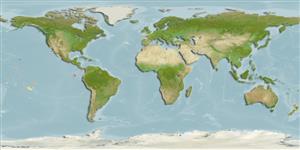Common names from other countries
Classification / Names / Names
Namen | Synonyme | Catalog of Fishes (gen., sp.) | ITIS | CoL | WoRMS
Environment: milieu / climate zone / depth range / distribution range
Ökologie
; brackwasser; tiefenbereich 1 - 2 m (Ref. 101353). Temperate
Eastern Central Pacific and Northeast Atlantic: Mexico, Panama and UK.
Length at first maturity / Size / Gewicht / Alter
Maturity: Lm ? range ? - ? cm Max length : 25.0 cm SHL Männchen/unbestimmt; (Ref. 101485)
Depth range is based on occurrence in Mexico (Ref. 101353); to be replaced with a better reference. Mostly inhabits the intertidal zone (Ref. 106881). Found in mangroves (Refs. 101351, 106881), estuaries and coastal lagoons associated with mangrove roots (Ref. 106881). Eurythermal and euryhaline (Ref. 106881).
Life cycle and mating behavior
Geschlechtsreife | Fortpflanzung | Ablaichen | Eier | Fecundity | Larven
Members of the class Bivalvia are mostly gonochoric, some are protandric hermaphrodites. Life cycle: Embryos develop into free-swimming trocophore larvae, succeeded by the bivalve veliger, resembling a miniature clam.
The British Flora and Fauna Database. 2007. (Ref. 8593)
IUCN Rote Liste Status (Ref. 130435)
CITES Status (Ref. 108899)
Not Evaluated
Not Evaluated
Nutzung durch Menschen
Fischereien: kommerziell
FAO - Aquakultur: production; | FishSource | Sea Around Us
Tools
Internet Quellen
Estimates based on models
Preferred temperature
(Ref.
115969): 12.4 - 26.9, mean 19 (based on 123 cells).
Widerstandsfähigkeit
hoch, Verdopplung der Population dauert weniger als 15 Monate. (K=1.08-1.1).
